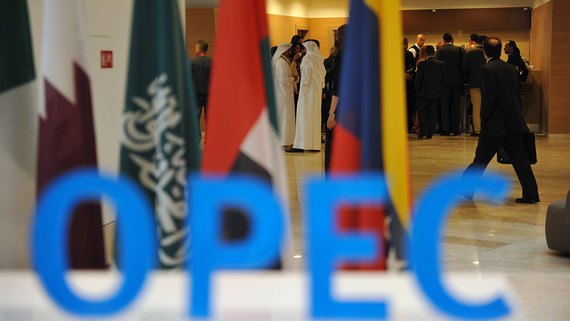OPEC cut oil production in May by 464,000 barrels per day
[ad_1]

The states of the Organization of the Petroleum Exporting Countries (OPEC) in May 2023 reduced oil production by 464,000 barrels per day compared to April this year to 28 million barrels per day. This is stated in the monthly report of OPEC, published on June 13. At the same time, daily oil production in the world decreased over the same period compared to the previous month by 1 million barrels. and amounted to 100.2 million barrels. It still remained at 1.7 million barrels. higher than in May 2022
The reduction in production in OPEC countries was due to voluntary production cuts by nine countries that acceded to the OPEC + agreement, which entered into force on May 1. In total, these countries should reduce production by 1.66 million barrels per day. The largest part of the reduction – 1.039 million barrels per day – falls precisely on OPEC members. Saudi Arabia is to cut production by 500,000 b/d, the UAE by 144,000 b/d, Iraq by 211,000 b/d, Kuwait by 128,000 b/d, Algeria by 48,000 b/d. /day and Gabon – by 8000 bbl./day.
Of these, only Saudi Arabia has achieved the cut so far, with the country’s production down 519,000 b/d in May from April to 9.98 million b/d, the report said. The UAE has almost reached its target: in May, the reduction was 140,000 bbl/d, daily production fell to 2.9 million bbl.
Kuwait cut production by 95,000 b/d to 2.6 million b/d, and Algeria by 36,000 b/d to 974,000 b/d. At the same time, Nigeria, Iran and Angola increased their daily production in May: Nigeria increased oil production by 171,000 barrels per day to 1.27 million barrels per day, Iran – by 61,000 barrels per day to 2.7 million barrels ./day, Angola – by 54,000 bbl/d to 1.14 million bbl/d.
Another 40,000 barrels per day should cut production from May 1, Oman, which is part of OPEC +. Decrease in Kazakhstan – 78,000 bbl/d, and in Russia – 500,000 bbl/d. The Russian Federation has already reached the target level, Deputy Prime Minister of the Russian Federation Alexander Novak reported in early May. The Russian authorities announced a voluntary cut in the country’s oil production in February of this year. This decision will be valid until the end of 2024. Moreover, the reduction of domestic production this year, according to Novak, will be made “from the level agreed upon at the meeting on June 4.”
On June 4, the ministers of the OPEC+ countries met, at which they agreed to reduce the quota for oil production from the current level by 1.6 million barrels per day from January 1, 2024. The total quota will be 40.46 million barrels per day. The oil production quota for Russia will be significantly reduced by 650,000 barrels per day, Nigeria – by 362,000 barrels per day, Angola – by 175,000 barrels per day, Malaysia – by 166,000 barrels per day. At the same time, Saudi Arabia’s quota will remain at the current level of 10.48 million barrels per day, while the UAE’s quota will increase by 200,000 barrels per day. At the same time, Riyadh on June 4 promised to further cut production by another 1 million barrels per day.
OPEC+ countries, which have announced a voluntary cut in oil production, may reach the target level of reduction of 1.66 million barrels per day by the third quarter of this year, Andrey Maslov, an analyst at FG Finam, believes. According to him, many OPEC+ countries are “rather happy with the planned production cuts” due to a chronic lack of investment in the industry and poor supply logistics.
The voluntary cut in oil production has kept oil prices from falling below $70/bbl, Maslov said. At the same time, in the coming months, prices will be supported by an increase in demand for oil in the summer, adds Kirill Rodionov, an expert at the Institute for the Development of Fuel and Energy Complex Technologies. But the key factor for the market is likely to remain the policy of the US Federal Reserve, which from March 2022 to May 2023 raised the key federal funds rate 10 times. If the Fed continues its policy of raising the rate, Rodionov explains, the cost of Brent will remain near $75/bbl.
Maslov expects Brent to be in the range of $75-85/bbl in 2023 and $70-80/bbl next year. At the same time, a barrel of Urals, Maslov notes, will cost $50-60 in 2023, and $45-55 in 2024. Ronald Smith, senior analyst at BCS World of Investments, agrees with him. According to his forecast, in 2023 the average price of Brent will be $79/bbl, Urals – $57/bbl.
The Russian Ministry of Finance determined the average price for Urals in January-May 2023 at $51.5/bbl, in May – $53.34/bbl. According to the ICE exchange, on June 13, Brent futures for August traded at $74.4/bbl.
[ad_2]
Source link





